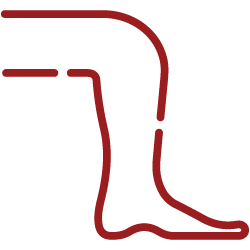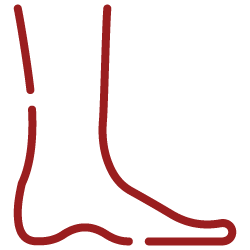– Surgeries & Procedures –
OSI Services
– Services –
Surgeries & Procedures Performed
Orthopedic Surgeons, Inc. provides state-of-the-art orthopedic care to meet our patients’ many needs. OSI is your trusted provider for orthopedic care, addressing a wide range of injuries and conditions that affect mobility and quality of life.
We understand that repetitive physical activities, whether from sports or daily routines, can increase the risk of certain orthopedic conditions. That’s why our team of experts is dedicated to offering the latest services, techniques and treatments to evaluate, diagnose, and address these issues effectively.
At OSI, we prioritize prompt and personalized care to facilitate full recovery and enhance overall well-being. Whether you’re an athlete striving to return to their sport or someone dealing with an injury from everyday activities, we’re here to support you on your journey to optimal health and mobility. Explore our services below.

Shoulder
Total Shoulder Replacement
Total shoulder replacement, also known as total shoulder arthroplasty, is a major surgical procedure in which your orthopedic surgeon replaces the damaged ball and socket joint of the shoulder with a metal replacement ball on a plastic surface on the socket.
This procedure is often performed to treat severe, ongoing pain caused by degenerative conditions such as osteoarthritis or serious injury. With the right help from a skilled orthopedic surgeon, patients undergoing total shoulder arthroplasty can experience full recovery, find relief from pain, and restore their range of motion so they can participate in the activities they love.
Talk to one of our orthopedic surgeons to see if your condition warrants a possible total shoulder replacement.
Reverse Shoulder Replacement
Sometimes, the rotator cuff in a shoulder can be damaged beyond repair. This can also lead to a painful condition known as cuff tear arthropathy, which is a form of shoulder arthritis. When these conditions happen, a traditional total shoulder replacement is not an effective form of treatment. The alternative is called a reverse shoulder replacement.
A reverse shoulder replacement uses different muscles to help the arm move than what are used normally. Since the rotator cuff muscle can’t function, the design of this implant takes advantage of other muscles – such as the deltoid muscles in the shoulder – to move the arm instead.
You may be a candidate for reverse shoulder replacement if you have cuff tear arthropathy or a severe fracture of the proximal humerus. If so, your orthopedic surgeon at OSI can walk you through the process and help you understand what the treatment will entail and how it will help you.
Rotator Cuff Repair
The rotator cuff in your shoulder helps you raise and rotate your arm. It is a vital part of your arm’s full range of motion, and when it is torn or damaged, your mobility will become impaired. You may also experience significant weakness and/or pain.
Rotator cuff surgery is usually required if nonsurgical techniques don’t relieve the pain. There are two options: a surgeon can reattach the torn tendon in the case of a full tear; or, a surgeon can perform a debridement (trimming or smoothing the tendon) in the case of a partial tear.
Rotator cuff repair is often done through arthroscopic surgery. Arthroscopic surgery for the shoulder helps to address injuries to your shoulder joint and the surrounding tissues by using a tiny camera – called an arthroscope – through a small incision into your shoulder so the surgeon can examine the tissue and the joint. If repairs are necessary, they can be made via a series of additional incisions. This is a minimally-invasive way to repair the damage to your rotator cuff.
Talk to a trained orthopedic surgeon at OSI to learn more about rotator cuff repair and how it may benefit you and give you the improved mobility you deserve.
Labral Repair
The labrum is a ring of cartilage that site on the rim of your shoulder socket. It helps promote stability in your shoulder and also support the joint in movement. A labral tear can cause problems with stability and mobility, as well as pain. Athletes are particularly vulnerable to torn labrums, but anyone who has experienced trauma to the shoulder – such as falling down stairs or getting into a car accident – can suffer from this injury.
Labral tears may stop hurting with intervention, such as anti-inflammatory medication, cortisone injections, and physical therapy. But sometimes, surgery is required in order to repair the tissue back to the bone.
Labral repair surgery is usually performed with minimally invasive arthroscopic surgery in which surgeons operate through small incisions in the shoulder with the aid of a small camera inserted into the joint. This results in a faster recovery time and fewer complications from the surgery.
An OSI orthopedic surgeon can diagnose your injury and give you advice on whether or not labral repair surgery is needed.
Fracture Care
The shoulder is a complex mechanism that is as susceptible to fracture as any other bone-based mechanism. Shoulders usually become fractured through traumatic events, such as accidents or falls, but a fracture can also develop over time through overuse.
Our surgeons are skilled at diagnosing and treating fractures of the shoulder, whether they require nonsurgical or surgical intervention. If your shoulder fracture requires surgery to fully heal, our surgeons have years of experience and training that will put you in the best position to recover.
Superior Capsular Reconstruction
In the event of an irreparable rotator cuff tear that can’t otherwise be fixed by surgery, an orthopedic surgeon may have to use what is called superior capsular reconstruction to restore mobility and reduce pain.
Using an arthroscopic scope (a small camera placed into the shoulder via an incision), the orthopedic surgeon will debride the damaged rotator cuff tissue and then reconstruct the superior capsule, which lines your shoulder joint. The superior capsule can perform a similar function as the rotator cuff, enabling an improved range of motion even though the rotator cuff is inoperable.
Superior capsular reconstruction isn’t for every case, and your orthopedic surgeon will have to determine whether it is appropriate for your particular situation. But it can be a viable alternative to an injury that otherwise would be very difficult to treat. Talk to your orthopedic surgeon to learn more.

Elbow
Tommy John Surgery
Named for former Major League Baseball pitcher Tommy John, Tommy John surgery is designed to reconstruct the ulnar collateral ligament, or UCL. The UCL is on the inner part of your elbow and helps to connect your upper arm bone to a bone in your forearm. When this ligament is torn – usually by repeated throwing motions, like pitching – the patient may experience an inability to perform certain motions.
UCL injuries most commonly occur in athletes. Tommy John surgery is designed to help these athletes regain their ability to perform by taking a healthy tendon from elsewhere in the body and using it to replace the damaged UCL tendon in the elbow.
Using today’s technology, an athlete can fully recover from a UCL injury with a Tommy John surgery. Contact your orthopedic surgeon at OSI to schedule a consultation and see if this surgery is recommended for your situation.
Total Elbow Arthroplasty
Total elbow arthroplasty is also known as total elbow replacement. This procedure involves replacing damaged bones in the elbow with artificial components made from metal and plastic. Candidates for total elbow arthroplasty suffer from pain and disability, usually caused by anything from degenerative joint disease (osteoarthritis), rheumatoid arthritis, serious elbow injuries and fractures, and chronic instability.
Surgery is usually inpatient and may require a hospital stay of 2-4 days following the procedure. Your surgery will be followed by a rehabilitation program that will help you avoid stiffness, maintain range of motion, and gradually regain use of your arm.
For more information about a total elbow arthroplasty procedure, contact your orthopedic surgeon at OSI and see if this procedure may be appropriate for you.
Fracture Care
Elbows may seem hard and resilient, but they can be just as prone to fracture as other parts of the body. A fracture of the elbow, if significant enough, can keep you from using that arm at all, or at least severely impact your mobility and function.
For minor fractures, rest and stabilization are all that are needed to heal the break. But orthopedic surgeons sometimes have to perform surgery on the break in order to repair it and help you regain function in your elbow and arm.
Our orthopedic surgeons are skilled at elbow fracture repair and can diagnose and treat a wide range of conditions affecting this important body part.
Arthroscopic Surgery
Arthroscopic surgery of the elbow is a minimally-invasive alternative to open surgery in which a tiny camera is inserted via a small incision into the affected area and used to diagnose and repair the damage in the elbow.
Since arthroscopic elbow surgery is less invasive, there’s potentially less pain and swelling with the operation than other techniques. You’ll also recover faster than with open surgery. It’s not recommended for all cases, but your orthopedic surgeon can tell you when arthroscopic surgery for your elbow would be the best course of action for you.
Ulnar Nerve Decompression/Transposition
The ulnar nerve is a nerve that runs down your inner arm, goes behind a bony prominence in your elbow (the medial epicondyle), and continues down to your hand. It is what produces the “funny bone” sensation when the inner elbow is bumped. As one of the main nerves in your arm, the ulnar nerve provides feeling and function to muscles in your arm and hand.
Sometimes, the ulnar nerve becomes pinched or compressed by the medial epicondyle or surrounding tissues, resulting in ongoing pain and weakness in the arm and hand. An ulnar nerve decompression or transposition are procedures in which the orthopedic surgeon decompresses and/or possibly relocates (transposes) the nerve to where it will no longer be compressed by the bone/tissues in your elbow.
Consult with an orthopedic surgeon to learn more about this technique and examine if this is a proper course of action for you.

Wrist & Hand
Carpal Tunnel
Treatment & Hand Surgery
Carpal tunnel syndrome affects countless Americans every year and results from pressure placed on the median nerve in your wrist. This can be the result of exposure to repetitive motions or vibrations. Carpal tunnel syndrome can result in chronic pain, numbness, and/or tingling, and can be addressed by a procedure called carpal tunnel release.
Our Kansas City hand specialists and hand surgeons are available and ready to help you at our Liberty, Blue Springs, MO, or North KC locations.
Carpal tunnel release solves carpal tunnel syndrome by giving the median nerve more room and is performed by cutting through a ligament at the top of the carpal tunnel, called the carpal ligament.
If you suffer from carpal tunnel syndrome and nonsurgical treatment hasn’t helped, a carpal tunnel release procedure may need to be scheduled. Ask a local Kansas City hand & wrist doctor at OSI if this may be the best option for you.
Trigger Finger Release
Also known as stenosing tenosynovitis, trigger finger is a condition in which there is a locking and painful sensation in your fingers and/or thumb. This is often developed through a repetitive gripping motion such as that used to hold a steering wheel, cell phone, tennis racket, or some other object. This can, over time, cause swelling at the base of your finger that can result in a painful, catching sensation when you try to straighten your finger.
There are nonsurgical ways to treat trigger finger, such as bracing or steroid injections but when these don’t work or if the condition is severe, surgery may be necessary. Trigger finger release is a procedure in which the surgeon cuts a ligament called the A1 pulley, allowing the tendon in your finger to pass through without being caught.
Consult with an orthopedic surgeon at OSI (Orthopedic Surgeons Inc.) to learn more about what trigger finger release entails and what it can do for your condition.
Basilar Thumb Joint Replacement
The hands and wrists are intricate and complex parts of your body made of several small joints that enable you to flex and move your hands and fingers. When these joints become damaged, either through degenerative diseases such as arthritis or through injury, they may need to be replaced. One of the main joints that we replace is the joint at the base of your thumb.
There are various techniques utilized to replace the basilar thumb joint. These include options such as using other tendons, a ceramic ball, or a suspensory device to reconstruct the joint. This can restore function and gives you full use of your hand and wrist while eliminating a source of chronic pain and inflammation.
If you’ve experienced ongoing pain, swelling, and stiffness in the joints of your hand, and nonsurgical intervention doesn’t help, then surgery may be required. Consult with the team at OSI to learn more about how surgery can be a good option for you.
Arthroscopic Surgery
Arthroscopic surgery involves taking a tiny camera – an arthroscope – and inserting it into the wrist via a small incision so that the surgeon can see what’s going on inside the joint. Based on what they see, the hand surgeon can then make repairs to the damaged structures through other small incisions in the skin.
Arthroscopic surgery for your wrist is a minimally invasive form of surgery that is used for various problems but it may not be possible or recommended for your specific condition. A surgeon at OSI can help you make that decision.
Hand & Wrist Fracture Care
Fractures commonly occur in the hands and wrists. Sometimes, these fractures are stable or non-displaced and can heal on their own, with a care regimen in place. Others are more serious, and require surgery from an orthopedic hand specialist to fix the break and put the bone in a position where it can heal properly.
It takes careful skill and precision to carry out surgery in such a relatively small and compact part of the body. A Kansas city orthopedic hand surgeon with experience in hand and wrist surgery is recommended if you need to pursue surgical options for treatment.

Hip
Total Hip Replacement
Including The Anterior Approach
Each year thousands of patients undergo total hip replacement surgery. There are various ways to actually perform this procedure. One of them is the anterior supine inter-muscular (ASI) approach, or what is commonly referred to simply as the anterior approach. This uses an incision on the front side of the hip to allow direct access to the joint. This is unique in that it is a muscle-sparing technique, meaning no muscles need to be detached from the bone during the procedure. This can potentially mean less postoperative pain, quicker recovery, and a faster return to your day-to-day activities.
Not all patients and conditions are ideal for this technique however and more traditional approaches can still lead to great outcomes. Talk to one of our Kansas City surgeons at OSI to find out what your best option for hip replacement surgery may be.
Labral Repair
The labrum is a fibrous piece of cartilage in your hip that helps stabilize the joint. When it is torn, the patient often feels pain and will have a loss of mobility on that side of the body. These tears are caused either by degenerative conditions or by traumatic injuries.
Orthopedic surgeons can use a variety of methods to address torn labrums, including hip arthroscopic hip surgery – a minimally-invasive surgical method using small incisions to access the injured area.
Talk to an orthopedic surgeon in Kansas City at Orthopedic Surgeons, Inc, if you have had a labral tear diagnosed and are in need of labral repair surgery.
Arthroscopic Hip Surgery
Arthroscopic surgery for the hip is a procedure in which orthopedic surgeons insert a camera through a small incision into the hip area to inspect the joint and surrounding tendons. This is both a diagnostic tool and a restorative one, as surgeons can use additional small incisions and precise instruments to make repairs to the hip area without a more invasive, open surgery.
Some injuries to the hip do not require total hip replacement or resurfacing. In these cases, arthroscopic surgery may be recommended. This is particularly true if there is damage to the labrum, which is the tissue around the socket.
Arthroscopic surgery is also useful to treat cases of hip impingement, in which the ball and socket of the hip joint wear against each other and cause more friction that will ultimately result in damage to the joint.
A qualified orthopedic surgeon can give you a diagnosis and a recommendation for or against arthroscopic surgery. Talk to a Kansas City surgeon at OSI to learn more about the benefits of arthroscopic surgery for the hip.
Fracture Care
As with any body part made of bone, the hip is vulnerable to fractures. In fact, among senior citizens and those with a degenerative bone disease, hip fractures are some of the most common and disruptive orthopedic injuries suffered in the U.S. each year.
Not every hip fracture will require surgery. In those cases where surgery is not required, rest, physical therapy, and pain medication can help facilitate healing. But should a fracture be serious enough to need surgical intervention, the team of orthopedic surgeons at OSI can give you a treatment plan that involves the least disruption to your lifestyle and the best chance at a full recovery.

Knee
Total Knee Replacement
Destruction of the knee joint can be caused by degenerative conditions or by traumatic injury. If your knee has been damaged to the point where you can’t walk, climb stairs, or even sit, then you may need a total knee replacement by a professional knee doctor or knee specialist in the Kansas City metro.
This procedure is has become quite common; each year, roughly several hundred thousand knee replacements are performed. During this surgery, the orthopedic surgeon will “resurface” the joint with metal and plastic implants. This is much like a dentist placing a crown on a tooth. The implants effectively cover and protect the raw exposed bone from further friction and damage leading to a dramatic decrease in pain.
Total knee replacement isn’t recommended for everyone, but it can be a viable and successful option to eliminate chronic, severe pain that won’t go away with nonsurgical intervention. Talk to an orthopedic surgeon at OSI to learn more about total knee replacements and how they can help you regain the quality of life and mobility you desire.
Partial Knee Replacement
An alternative to a total knee replacement, a partial knee replacement (also known as a unicompartmental knee replacement) resurfaces just a portion of the knee with metal and plastic implants. Partial knee replacement is typically for those whose knee damage is limited to a specific area of the knee as opposed to the entire knee. This procedure is less invasive and can result in a quicker recovery time than a total knee replacement.
Fracture Care
The knee is made up of the junction of the femur, tibia, and patella. Fractures can occur through any of these bones and are often associated with falls or higher energy accidents such as car wrecks. These fractures can potentially be treated with or without surgery but usually depends on factors such as the fracture pattern, location, overall health of the patient, and other injuries. When surgery is indicated it can help restore the joint surfaces back to a more natural position, allow for an earlier range of motion, and sometimes a quicker return to function.
Our orthopedic surgeons have experience in dealing with fractures about the knee and understand the delicate nature of the knee and how best to handle this vital part of the body. Talk to one of our surgeons to learn more about treating a knee fracture and the best way to best recover from it.
MAKOplasty Robotic Knee Replacement
A MAKOplasty knee replacement is a robot-assisted unicompartmental (or partial) knee replacement surgery. A special robotic arm is guided by a computer to assist the orthopedic surgeon in making sure the components used in the replacement are properly aligned. This can create more consistent results and potentially increase the longevity of the procedure. Talk to your orthopedic surgeon to see if MAKOplasty robotic knee replacement is an option for you.
Arthroscopic Knee Surgery
Arthroscopic knee surgery is a procedure that uses small incisions around your knee through which a small camera – an arthroscope – is placed to visualize the inside of your knee. This allows your surgeon to check out the damaged area and make repairs in a minimally-invasive way, whether it’s fixing a tear in a meniscus, addressing cartilage/ligament damage, or debriding scar tissue.
Since it is minimally invasive, arthroscopic knee surgery typically results in a shorter recovery time, meaning you’ll be back on your feet faster than with other techniques. Consult with your knee specialist at OSI to determine if a knee arthroscopy is recommended for your course of treatment.
Ligament Reconstruction
ACL | MCL | PCL | LCL
Your knee has four major ligaments that help hold the joint together: the anterior cruciate ligament (ACL); posterior cruciate ligament (PCL); medial collateral ligament (MCL); and lateral collateral ligament (LCL).
These ligaments can become partially or completely torn through various accidents but are often associated with sporting injuries, falls, or car wrecks. This usually happens as a result of a sudden change of direction, deceleration while running, or blunt force to the knee.
There are three degrees of severity: grade I, grade II, and grade III. It is possible to avoid surgery with any grade, but for athletes and those who want more stability in the future, surgery may be recommended.
In an ACL, MCL, LCL, or PCL surgery, the orthopedic surgeon will either repair the torn ligament directly or will replace it completely with a tendon grafted from another part of the body or taken from a donor (cadaver). For ACLs in particular, traditional treatment consists of reconstructing the ligament with a graft but there is some newer literature suggesting certain tears may actually heal with a direct repair.
Talk to an orthopedic surgeon at OSI to get a full suite of options for treating damage to the ligaments in your knee.
Osteotomy of The Knee
An osteotomy is a procedure that cuts part of the bone in the affected area to help reduce pain and increase mobility by transferring weight to a healthy part of the knee and correcting bad alignment. Advantages of an osteotomy are that it can delay a knee replacement and get you back to your normal routine – even high-impact sports – immediately.
An osteotomy may not be recommended for everyone. If you qualify, your orthopedic surgeon will walk you through the pros and cons of the procedure and give you a professional recommendation as to what you should do and what you can expect.
Meniscal Knee Surgery and Transplant
The meniscus is a thin piece of cartilage between the surfaces of the knee joint that serves as a shock absorber for your knee. When healthy, they help to cushion the joint. When torn or damaged, though, they can result in pain or an inability to move and function as normal.
Meniscal surgery is typically performed with arthroscopic visualization and involves either attempting to repair the torn meniscus or trimming the torn portion away. This decision is based on a variety of factors such as age/overall condition of the knee, the location of the tear within the meniscus, and tear orientation.
In certain circumstances, such as a young patient who has had their meniscus previously removed, it may be beneficial to replace the meniscus entirely. In a meniscal transplant, your orthopedic surgeon will replace your damaged meniscus with one from a cadaver donor. This can help restore function in your knee and eliminate the pain resulting from your bones rubbing against each other.
Talk to an orthopedic surgeon at OSI for more information on which of these options is best for you if you are diagnosed with a meniscal tear.

Ankle & Foot
Fracture Care
The foot and ankle are a complex part of our skeleton. Unfortunately, due to the nature of being on our feet throughout our life and the various activities we are involved in, these areas are at high risk of injury. Fractures of the foot and ankle are quite common. They can range from rather simple to extremely complex. Subsequently, our Kansas City foot & ankle treatments can vary widely depending on the nature of the injury.
Proper alignment and stability is vital for successful, pain-free outcomes after fractures to these areas. Sometimes this can be achieved non-operatively but other times surgery is necessary to optimize outcomes. At OSI our local orthopedic surgeons are well versed at dealing with these types of injuries and can provide you with proper recommendations and treatment when needed.
Ankle Fusion Surgery
An alternative to joint replacement, an ankle fusion surgery (or ankle arthrodesis) seeks to relieve pain in the ankle by removing motion from the ankle. In this surgery, the bones that make up your ankle joint are fused together into one bone. Because these bones will no longer move against each other in an up and down motion, the pain can be reduced or eliminated.
Not every person is a candidate for ankle fusion, and ankle fusion may not be preferable to another course of treatment. It’s important to consult with your Kansas City orthopedic surgeon to find out if ankle fusion is recommended for you.
Arthroscopic Ankle Surgery
Arthroscopic surgery of the ankle is an effective means to address various injuries in a less-invasive manner than open techniques. In this procedure, a small camera is inserted into the joint through small incisions to help diagnose and treat the condition. This can help expedite the recovery process by being less disruptive to the surrounding soft tissues.
Not all injuries or conditions can be treated with arthroscopic surgery. Your KC orthopedic surgeon at OSI will suggest the best course of action for your particular foot or ankle situation.

Orthopedic Care
Orthopedic Bracing
Orthopedic Surgery isn’t recommended for all injuries and conditions. For many orthopedic conditions, nonsurgical treatments are sufficient – and this includes orthopedic bracing and other sports medicine treatments.
Orthopedic bracing is designed to stabilize various parts of your body and promote healing and recovery in the event of an injury, or to help in mobility and function. Sometimes, a well-fitted brace is the best treatment for a condition or injury.
Platelet-Rich Plasma Injections
To assist in the healing of injured ligaments, tendons, joints, and muscles, OSI offers platelet-rich plasma injections that use a patient’s own blood to promote healing through a concentrated application of platelets and other circulating healing factors in the bloodstream.
Platelets are what the body uses to help heal wounds and injuries. When blood that is rich in platelets is injected into an affected area, that area can potentially heal and recover faster than it would without the injections.
Platelet-rich plasma has been shown to reduce pain and increase function in a wide variety of areas, such as tendinosis in the elbow, hip, knee, wrist, shoulder, and ankle. It is also being applied to treat osteoarthritis. Since the plasma comes from a patient’s own blood, the chance that the body will react to the injection is minimal.
Talk to an orthopedic surgeon or sports medicine specialist at OSI to learn more about the benefits of platelet-rich plasma injections and how they can promote better healing for your condition.
Stem Cell Injections
Bone Marrow Aspirate Concentrate
Stem cells are immature cells found in our bone marrow. These cells are unique because they have not necessarily differentiated into what type of cell they are ultimately going to become. This theoretically gives them the potential to help repair damaged tissue.
These cells are usually obtained from an area on the back of the pelvis. A local anesthetic is used to minimize the discomfort felt during this process. The bone marrow is then placed in a specialized centrifuge which will separate out the stem cells. The stem cells or “bone marrow aspirate concentrate” are then injected back into the area of concern.
This is a very exciting and promising treatment option for various problems. Although stem cell therapy could be used in a number of situations, current research suggests conditions such as osteoarthritis and severe tendon injuries show promising results.
Viscosupplementation Injections For Osteoarthritis
Osteoarthritis is a condition that causes inflammation in the bones and joints of your body. One effect of this condition is that your joints – particularly your knee – contain a lower concentration of something called hyaluronic acid, which is found in the fluid surrounding a joint that keeps it lubricated.
Viscosupplementation injections for osteoarthritis are injections that place hyaluronic acid into the joint fluid, helping to increase movement in the joint, reduce pain, and sometimes even help impede the progress of osteoarthritis. This can be a nonsurgical treatment option that can improve the pain and immobility caused by osteoarthritis.
Speak with an orthopedic surgeon at OSI to learn more about these injections and if they would be recommended for your case.
Walk In Clinic
Orthopedic Urgent Care open Mon-Fri – 8:00 AM – 8:00 PM, Sat – 8:00 AM – 12:00 PM. Closed Sunday. Walk-ins Welcome!
No appointment or call ahead needed. Please have an insurance card. New or established patients are welcome for orthopedic care.
Service Areas
For Patients
Contact
P • (816) 459-7500
F • (816) 459-9611
Email Us
osisecretary@osikc.com
Please do NOT email OSI to schedule appointments








